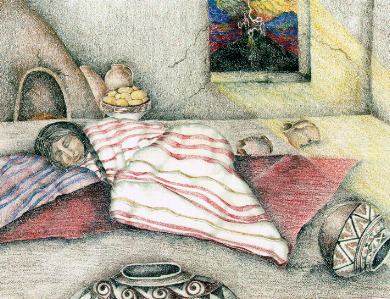Teachers
Guide to Stratovolcanoes of the World
A Fictional Story
Nevado
del Ruiz, Colombia:
Facts
| Story | Feature | Questions
A Fictional Story - Rosita of Armero
On November 13, 1985, twelve-year-old Rosita was awakened by the sound of clattering pottery jars on the dirt floor. As she sat up on the mat bed she shared with her sisters, she felt dizzy. The clay pots were not the only things shaking. Even the floor of Rosita's adobe home was shaking. Outside a roof tile fell to the ground. Rosita cried out.
"Hush," her mama said, "It's only the volcano shaking."
Rosita lived in Armero, a small town 74 km (44.5 mi) from
the base of Nevado del Ruiz.

Rosita lay back down on her mat bed. The night was silent now. The clattering had stopped. Still, something did not seem right. Rosita went outside the adobe hut and looked toward the volcano. The night was unusually dark. There was a storm brewing in the mountains. Lightning flashed across the sky. Soon rain began to fall, forcing Rosita back into her home. As she sat on her mat, she thought about the volcano. Just yesterday, a white cloud of steam rose from the mountaintop. On nights when the sky was clear, she had seen a warm orange glow. Still the volcano was a long way from Amero, four hours by car over bumpy roads.
Earlier this year some scientists from the city had come to Armero. They took measurements and drew maps. Some of them dug in the ground around the village and looked closely at the soil. The scientists told Rosita's teacher that mud from the volcano reached Armero 140 years ago.
Rosita had been curious. "How do you get mud from a volcano?" she asked.
Remembering these things, Rosita was unable to sleep. She lay quietly in bed when she heard a strange swishing sound, and a sound like twigs snapping. Her curiosity drove her to the door of her hut. The storm had stopped and the moon was out. Rosita could see the bright orange glow at the volcano top. She looked for the source of the swishing. What she saw made her freeze. A wall of mud filled with trees was rushing towards the sleeping village. As Rosita watched in horror, the mud hit the first of the homes in the village. Rosita screamed, waking the household. Papa grabbed Rosita's little sister.
"Quick, up the hill," he shouted.
The family scrambled to safety just as the mud engulfed their home. In stunned silence, they looked out over the valley where the town had been. Everything was gone.
Officials from the government of Colombia and reporters from newspaper, radio, and television arrived in the morning. Rescue crews were sent to the scene but were unable to reach those trapped in mudflows up to 40 m (132 ft) thick. Twenty three thousand people died that night in Armero, and in villages nearby. Three quarters of the people living in the Armero were swept away or drowned in the few minutes it took for the swiftly moving mud to cover the town.
Rosita and her family are fictitious characters, but the deaths and destruction in Armero really happened.
Note: Good would come from this disaster. The U.S. Geological Survey organized a team with a portable volcano observatory that could be quickly sent to an awakening volcano anywhere in the world. They realized the eruption history of a volcano is very important. If we know when the volcano last erupted, how often eruptions occur, and what areas were affected by past eruptions we can develop better hazard maps and warnings. The impact of future disasters will be lessened because of what was learned here.
